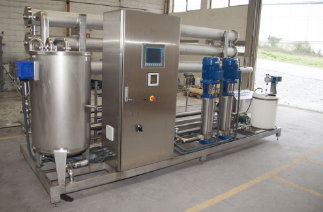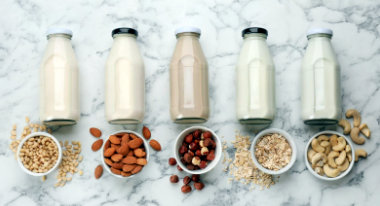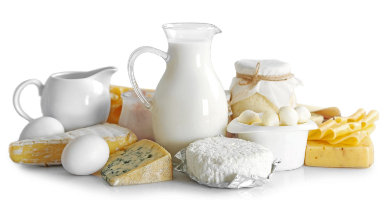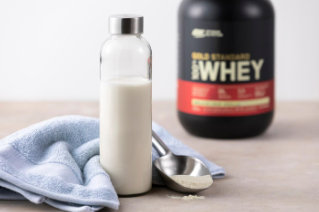In recent times, there has been a growing interest in protein-rich dairy products and their impact on health. Some parents of young children choose foods high in protein for their children and even for themselves. High protein milk is a clear example of these products.
It should be noted that an increase in the consumption of protein milk as a post-workout drink and to increase protein intake in older adults has also been observed. Given this trend, it is important to delve deeper into the possible benefits and adverse effects of recommending high protein milk or simply protein milk to clients, especially dietitians.
What is high protein milk and where is it found?
High protein milk is characterized by having 50% more protein and half the natural sugars (lactose) compared to regular or classic milk. This ratio is achieved through innovations in the use of an ultrafiltration process in dairy products that increases the concentration of protein and calcium in milk.
The ultrafiltration process is an advanced technique used to produce high protein milk . It is based on the separation of larger molecules from smaller ones in the liquid. During ultrafiltration, milk is pressurized and forced through a special membrane that retains proteins and calcium, allowing the resulting liquid to have a higher concentration of these nutrients.
It is a reliable method that has revolutionized the dairy industry by providing an efficient way to increase the amount of protein in milk without the need to add additives or artificial ingredients. Additionally, ultrafiltration can remove a significant portion of natural sugars, such as lactose, making the resulting product an attractive option for those looking to reduce their sugar consumption.

Types of milk with more protein
Let's look at some versions marketed according to the production process.
Ultrafiltered milk
They are milk filtered with the purpose of removing lactose. These products have a high concentration of protein and calcium. To give you an idea, one cup of ultrafiltered milk has 13 grams of protein (50% more than regular milk). Ultrafiltered milk is an advisable option for people who are lactose intolerant. Due to its production process, it does not contain lactose .
Milk with proteins and without lactose
Cow's milk can be treated with a lactase enzyme to remove lactose. Among lactose-free milk products , there are high-protein options. It is possible to purchase certain brands of lactose-free milk, which is high in calcium, vitamin D, and 13 grams of protein per cup.
Does plant milk have a lot of protein?
No. In general, milks such as coconut, almond or oat milk do not have much protein. A cup of oat milk only contains 1 gram of protein, which is very little.

One of the highest protein plant milks is soy milk , which provides 6 grams of protein per cup . The best thing about soy protein is that it is complete (it has all the essential amino acids). It is a protein as complete as the one found in cow's milk. Mind you, the protein in soy milk has fewer essential branched chain amino acids compared to cow's milk. Cow's milk has a higher quality amino acid profile.
On the market, some plant milks specially manufactured to increase protein content are already coming out. Some products combine almond and cashew milk with added pea protein. A product like this could provide even 10 grams of protein despite being a plant-based milk, along with calcium and vitamin D. Check the ingredients label when buying plant-based milk.
Some plant milk brands are beginning to offer varieties with higher protein content. As an example, Silk® Original Protein is an almond and cashew milk blend that contains added pea protein. A one-cup serving of this drink provides 10 grams of protein, along with calcium and vitamin D.
Are you interested?:
What do milk protein products entail?
Milk has protein and the reality is that the dairy products market is broader than it seems. In the current market, various milk options are marketed, along with supplements and products for high-protein diets. These products are promoted to improve athletic performance, muscle development and recovery, and overall health.
Additionally, high-protein milk is considered helpful in achieving slow digestion and a gradual release of amino acids over time, which can promote satiety.
Health benefits of high protein milk
The rise in popularity of milk protein is largely due to the potential health benefits it can bring. For example, the following.
Promoting muscle development and strength
One of the most obvious benefits of high protein milk is its ability to promote muscle development and increase strength. This is especially important in the context of physical exercise and sporting activity. Protein is essential for muscle repair and growth, and this type of milk provides a high-quality protein source that can help athletes and those engaging in resistance training.

Reduced age-related muscle loss
As we age, we tend to lose muscle mass, which can lead to mobility problems and weakness. High protein milk , when combined with resistance exercise, has been shown to be effective in preventing age-related muscle loss. This is especially relevant for older adults who want to maintain their strength and functionality as they age.
Contribution to bone health
In addition to its muscle benefits, high milk protein may also play an important role in bone health. Calcium is essential to maintain strong bones. Milk is a natural source of calcium.
By increasing the calcium concentration in a high-protein product, milk can provide additional support for bone health.
Support in critical illness situations
In cases of serious illness or surgery, the body often requires increased amounts of protein for tissue repair and recovery. Milk protein becomes a valuable option to meet these specific nutritional needs and contribute to the recovery of patients.
However, protein is not the only nutrient that a patient should take into account to improve their health. In all cases, nutrition in general plays a key role in recovery.
During pregnancy and breastfeeding
In both periods, female nutritional needs grow significantly. High protein milk can be a convenient source of protein and calcium during these important stages.
In any case, you have to consult a health professional before making significant changes to your diet during both pregnancy and breastfeeding.

For children following a vegetarian diet
It is not new to say that veganism is growing significantly around the world, nor is it new that more and more people are starting this habit from an early age. Children who follow a vegetarian or vegan diet may face challenges getting enough protein and calcium from plant sources.
If you belong to this group or at least identify with a similar eating behavior, you should know that high protein milk helps meet crucial nutritional needs and ensure healthy growth and development.
Aspects to consider
Despite the potential benefits of high-protein milk , it is important to consider some issues before, for example, purchasing whey protein to ingest it in certain cases or simply following a diet with milk protein.
Additional cost
Milk with a high protein content is usually more expensive than regular milk. For this reason, you should evaluate whether the benefit justifies the additional expense (even if you think it does not affect your financial situation). Likewise, you have to evaluate whether or not the product provides you with the desired results.
Dietary variety
Substituting classic milk for the high-protein version can limit the variety of foods you consume. If you are an adult, you will not necessarily suffer problems. On the other hand, for children it is essential to modify eating habits in order to achieve a balanced diet.
Excessive consumption
The benefits of protein are clear. However, its excessive or very repetitive consumption, whether through milk or other sources, could produce adverse health effects. For example, it could increase the workload on the kidneys and, in some people, lead to kidney health problems.
Allergic reactions
Some people may be allergic to, for example, casein protein or whey. Before including high protein milk in your diet, it is essential to ensure that there are no food allergies or intolerances. In this sense, you are the one who knows your body best, so don't wait and consult a specialist when you suspect that a product is causing you discomfort.
Nutritional balance
High protein milk should not be considered a one-size-fits-all solution for nutritional needs. It is important for consumers to maintain a nutritional balance in their diet. This means including a variety of foods that provide all the essential nutrients.
Consult a health professional
Before making significant dietary changes, especially in special situations such as pregnancy, breastfeeding or critical illness, it is recommended to consult a health professional or a registered dietitian. Experts provide personalized guidance to make food decisions safe and appropriate for your needs.
Related protein products
Cow's milk is the most used product to manufacture protein powder supplements. Protein supplements are another convenient way to consume milk protein . Questions often arise about these products. We are going to explain the best-known milk protein supplements.
Casein protein
What is casein ? Milk contains two types of protein : casein and whey protein. The casein protein gives the liquid its characteristic white color and makes up 80% of the total proteins in cow's milk. Whey protein is the remaining 20%. Casein is in other dairy products such as cheese, yogurt, baby food, and many dietary supplements.

How are casein proteins obtained?
Casein protein supplements are made from skimmed milk. To obtain casein, the whey must be drained. Afterwards, the curdled milk that remains is washed with water, dried and ground. This is how the powdered casein that we find in sports supplements is obtained. The miscellar casein supplement is the most marketed. Up to 80-82% of the total weight of this product is protein.
Casein protein is ingested orally through shakes . The product is usually used to improve sports performance, diabetes or liver diseases, among other uses.
Whey protein
What is whey protein ? This is one of the two proteins in milk and makes up 20% of the total protein in said food. It is called "whey protein" . Like casein, whey protein is also complete and has all nine essential amino acids. In addition, it has a low lactose content.

How is whey obtained?
In cheese making, whey is a waste product. However, it is used to make whey protein supplements. Cow's milk passes quality tests and then enzymes are used to separate the curds from the liquid whey. This whey is pasteurized and its protein is concentrated and isolated. The process can be carried out with two different methods: membrane filtration and ion exchange technology .
- In membrane filtration , membranes with pores of different sizes are used to eliminate bacteria, defat the whey, allow the passage of carbohydrates and minerals, and retain whey protein. This process is carried out at cold temperature.
- In it ion exchange , specific protein components are selectively isolated. The raw whey is sent through a column that collects the proteins and separates them according to differences in their net charge. The other components, such as minerals and lactose, are removed by washing and processed to obtain a different ingredient. Ion exchange is one of the best methods for obtaining whey protein, since it allows you to select all the functional and nutritional proteins in whey (bioactive proteins such as immunoglobulin and lactoferrin). The result is a whey protein with less fat and lactose, better solubility and neutral flavor.
Both casein protein and whey protein are very complete and have excellent quality, as they have all nine essential amino acids. Therefore, both types of protein in milk are excellent for helping to develop and maintain muscle mass. However, there is a main difference between the two: casein is digested more slowly, so it is more used to reduce appetite and increase the feeling of satiety.
Benefits of casein
One of the most frequently asked questions is what casein is for . To clarify your doubts, you can read this section about casein and its benefits . Despite the similarities, casein is digested and absorbed by the body much more slowly than whey. According to old studies, this is because the acidic environment of the stomach causes casein to clot or gel. As a result, it takes your body almost twice as long to digest and absorb the same amount of casein as it does whey. For this reason, whey protein is generally described as a rapidly digesting protein, while casein is described as a slowly digesting protein. A common strategy among athletes is to buy whey protein to take after training and casein protein to take before bed . This is to take advantage of the absorption speed of each type of protein at the most advisable times.
The casein protein forms a kind of gel in the stomach that significantly slows down its digestion and absorption. Thus, the slow digestion properties of the casein protein and its nutrients offer several benefits.
- Muscle Building : Casein protein is an excellent option if your goal is to build muscle. Despite its slower rate of digestion and absorption, it has been shown to provide muscle-building effects similar to whey protein. Additionally, to build and repair muscle while you sleep, casein may be a better nighttime food. The gel that casein forms in the stomach provides a constant flow of amino acids to the muscles throughout the night, promoting muscle repair and growth.
- Reduces hunger : Milk proteins, especially casein, reduce appetite, increase satiety and delay the feeling of hunger. This is because it takes your body several hours to digest and absorb the nutrient. Adding casein protein to your diet can be helpful if you have a weight loss goal or trouble staying full between meals.
- A high concentration of beneficial nutrients : Casein supplements have many beneficial nutrients. Some casein protein powders are an excellent source of calcium, providing approximately 50% of the recommended daily value per serving. Calcium supports many bodily functions related to bone, muscle, and blood vessel health. Additionally, casein protein contains bioactive peptides, which have been shown to lower blood pressure similar to some antihypertensive drugs.
In addition to promoting muscle growth, casein protein promotes satiety and contains beneficial nutrients such as calcium and bioactive peptides.
Real studies on the effects of high protein milk
Here we present two cases of research on the effects of daily consumption of high protein milk.
Investigation 1
A randomized control trial evaluated the effects of consuming high-protein milk (250 ml, 30 g protein and 10 g carbohydrate immediately after exercise and 30 minutes before bedtime) on changes in body composition, strength, power and skeletal muscle. The study was carried out with 30 young men (aged 24 to 30 years and 13 to 17 months of training experience). The trial lasted six weeks with resistance training.
Participants were randomly assigned to one of two groups:
- Group 1 drank protein-rich cow's milk and did resistance training (n = 15).
- Group 2 consumed isoenergetic carbohydrates (9% maltodextrin) and did resistance training (n = 15).
After six weeks, energy and protein intake increased for group 1, which went from consuming 1.5 g of protein per kilo of body weight per day to 2.3 g of protein per kilo of body weight per day. Group 2 reported no change and continued to maintain 1.5 g of protein per kilo of body weight per day.
The conclusion after six weeks was that group 1 showed greater lean mass, strength and power (in the upper and lower body) compared to group 2, as well as higher levels of skeletal muscle regulatory markers.
No adverse effects were reported in either group. The results are limited because the research team did not evaluate skeletal muscle anabolism or use a gold standard method (an established, highly accurate method) to assess body composition and track changes in muscle mass. The study did not make it clear whether the reference substance for group 2 (isoenergetic carbohydrate) would be a typical or recommended choice for recovery.

Investigation 2
Another 12-week randomized control trial was conducted to determine the effects of high-protein milk (30 g protein per day) in 37 healthy, active older adults aged 50 years and older. Age-related decline in skeletal muscle mass had to be observed. The participants were divided into four groups:
- Group 1 drank high protein milk 2 times a day and did not exercise (n = 13).
- Group 2 drank high-protein milk 2 times a day and performed a full-body resistance training program (the training lasted 12 weeks and you had to train 3 times a week) (n = 13).
- Group 3 only performed resistance training.
- Group 4 acted as a control group and did not drink the milk or exercise.
Groups 1 and 2 had an increase in energy and protein intake after 12 weeks compared to groups 3 and 4. Groups 1 and 2 had an average intake of 1.2 g per kilo of body weight before up to date; this amount increased to 1.8 g per kilo of body weight per day. Protein intake remained stable in groups 3 and 4 at 1.4 g per kilo of body weight per day.
Improvements in skeletal muscle strength were observed thanks to the consumption of high-protein milk in both the lower body and the upper body and back. These benefits were only observed when milk intake was combined with resistance exercise. Additionally, results were seen within 6-12 weeks.
The conclusion of the study is that protein-rich milk can increase muscle strength in older adults who already consume high amounts of protein (about 1.2 g per kilo of body weight per day), but only if it is combined with strenght exercise. In these cases, high protein milk can increase strength more than regular milk or exercise alone.
The limitations of the study were that the sample of each group was too small, that the participants self-reported their activity levels and that there was no control over their diets and usual protein consumption.
Other information you should know
Protein milk ( high content) is a beneficial addition to the diet in specific situations. For example, when looking to increase muscle mass, prevent age-related muscle loss, support bone health and recovery during critical illnesses. It may also be helpful for children who follow a vegetarian diet.
However, it must be remembered that high protein milk is not the only solution for all nutritional needs and should not be consumed in excess. The additional price and the possible limitation of dietary variety cannot under any circumstances go unnoticed. Furthermore, in the case of children and healthy people in general, regular milk provides adequate nutrients without the need to resort to specialized products.
Ultimately, when dietitians work with their clients, they must carefully evaluate the potential benefits of high protein milk compared to regular milk as part of an overall dietary pattern.
In short, high protein milk is very useful and effective, but as long as you meet the necessary requirements for its consumption and you verify it.


![CÓMO MONTAR UN GIMNASIO EN CASA CON POCO PRESUPUESTO [GUÍA 2024]](/modules//smartblog/images/296-home-small.jpg)




